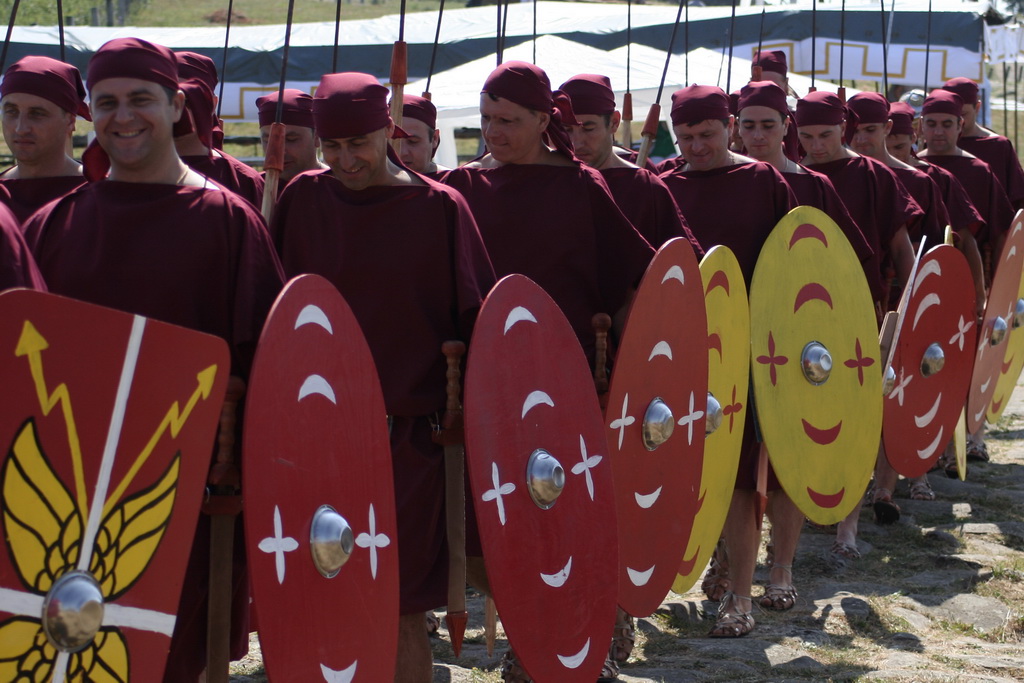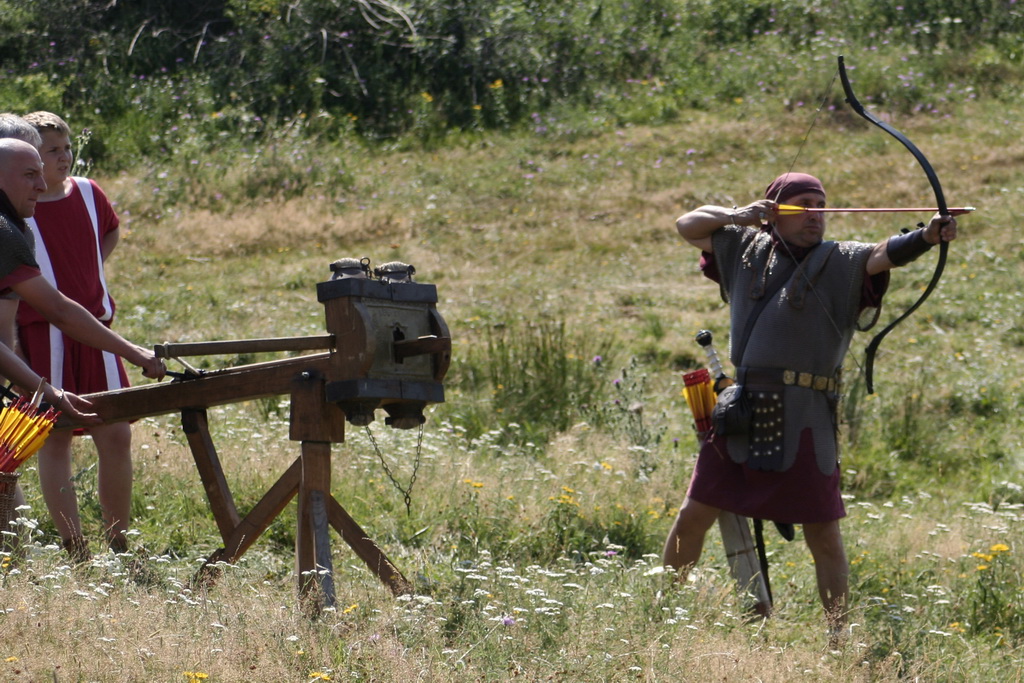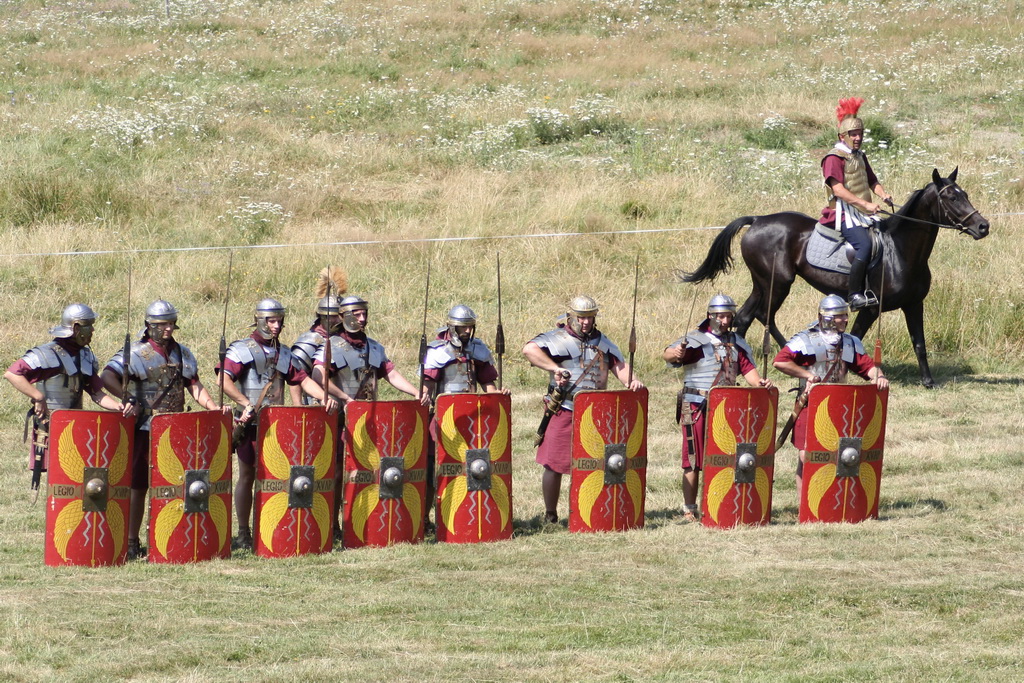History
The archaeological site of Porolissum contains an important prehistorically center (Neolithic, Bronze, Hallstatt) and Dacian, that are located on Măgura Moigradului (approx. 15 ha), as well as Roman forts, earth banks (on about 8 km in length), ditches and defense walls, two Roman forts, civil settlement of the large fort – military vicus, the urban civil settlement – the Roman city Porolissum, Roman necropolis, the Roman Amphitheatre, two lines of aqueducts on pillars, of about 300 m. All these elements of Roman civilization formed a military and urban center that was the capital of Dacia Porolissensis, organized by Emperor Hadrian, perhaps in 123 A.D. For the Roman city of Porolissum it is known the path of the outside wall, the location of the main entrance gates to the city, the main access roads – the stone roads on which there can be seen even today the markings of the Roman carriages. It was identified and partially researched the Roman city of Porolissum here in the middle of this area of over 30 hectares of land. This entire huge and important archaeological landmark is placed in the main pass of the valley from North-West of Dacia, pass which goes through the last branch of the Apuseni Mountains, where Meseş Mountain lays down. This pass is known in the history as Poarta Meseşană.
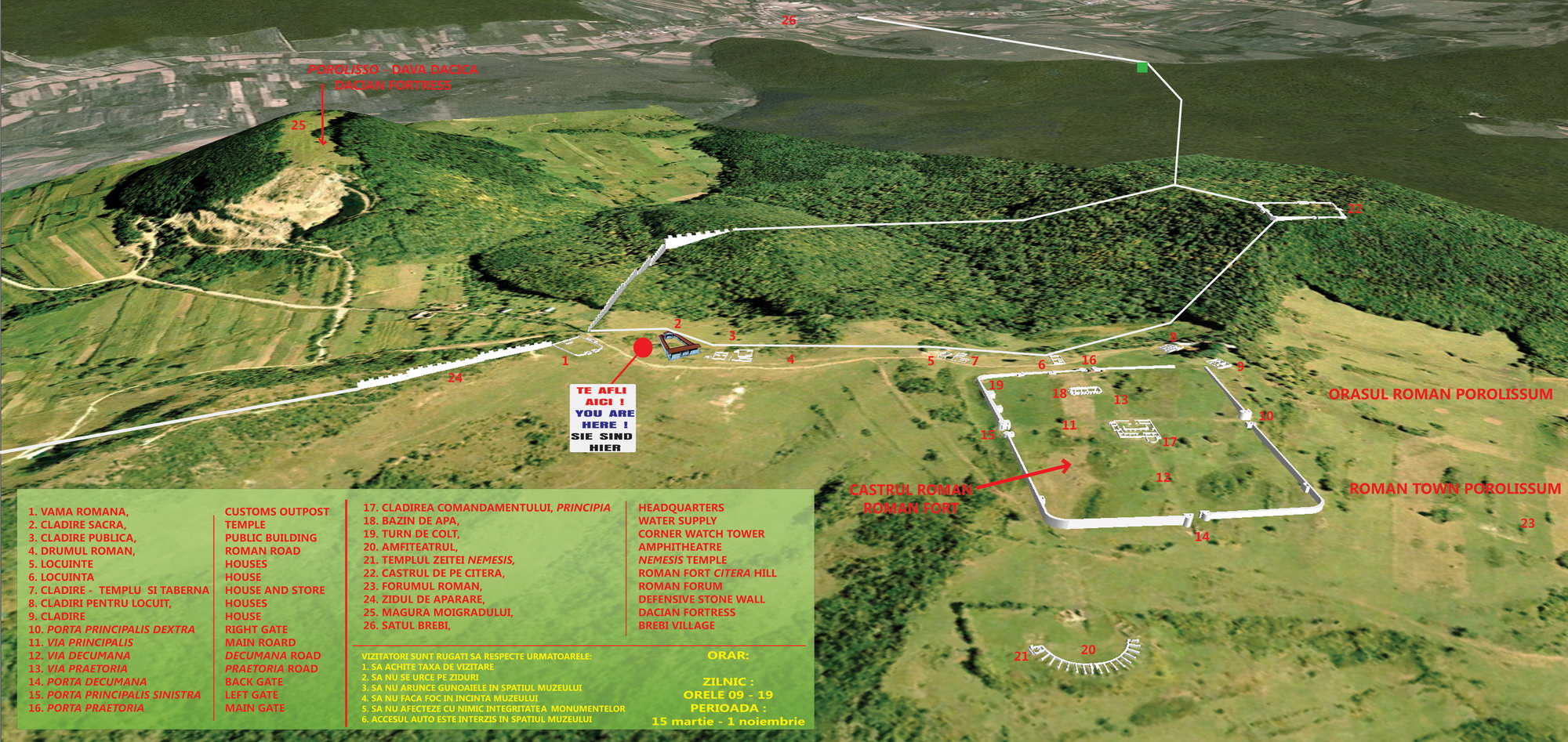
Porolissum was archaeologically identified by the end of the 19th century, but the first research was performed at the beginning of the 20th century and was continued in the interwar period.
The scientific research identified the main components of the site by revealing and partially researching the Dacian settlement Măgura Moigradului, the large fort (300 x 240m) on Pomăt Hill, the small fort (101x90m) from Citera Hill, the Amphitheatre, the sanctuary terrace, the Roman defensive system, banks, ditches of about 8 km long, and defense walls. The double bank – subsequently identified in line with a double aqueduct (civil and military) was built on pillars of 6x6m and respectively 3x3m, pillars that were made in full brickwork of stone bond in mortar and which had about 3-4 floors (approximately 30-35 m height).
\r\n
The archaeological research that begun in 1977 approached and revealed by systematic archaeological research the important objectives in the entire complex: the outside borders of the large fort of Pomăt Hill were set. Also on this occasion there were completely dug out the four gates and principia of the fort, and about 80% of the Roman arena was revealed, together with the main road (about 300 m) from the Sanctuary Terrace and also two temples and 7 dwellings that emerged in the military settlement (military vicus), and so did the gate on the Northern side of Porolissum, known by the markings made here, as the border check from Porolissum.
The archaeological research in the last 30 years at Porolissum were complemented by the conservation works – in situ – of all the researched buildings, in total 1.000 linear meters of Roman brickwork preserved in situ, that created here at Porolissum one of the largest open air archaeological museums in Romania.
Placed in the middle of the pass Poarta Meseşeană, on the plateau of Pomet Hill, that is the tallest hill in the surroundings (501m altitude), the Roman center of Porolissum, by the preservation works made here, became the most important tourist site in the North – West part of Romania.
The entire area of over 300 hectares in the archaeological site is free, not affected by more recent buildings, from medieval, modern or contemporary age, and the Roman walls are only covered in a few tens of centimeters of earth. One can very well study here all the composing elements of a Roman fort, of a civil settlement near the fort (military vicus), or of a Roman city with all its elements – forum, curia, macellum, outside walls, access gates, empire border or a Roman necropolis. The entire area contains the temples, the dwellings, the gates of the large fort, almost 500 linear meters of unrevealed street, the amphitheatre fully preserved and over 200 linear meters of outside walls from the large fort, all these monuments are preserved in situ. The area is set with paths, signs and indicators that describe each monument in Romanian and English language, thus becoming an enormous open air museum. Porta praetoria of the Pomet fort was fully restored, being so the only reconstruction of this kind in Central and South Eastern Europe. It is a landmark for the groups of tourists visiting the archaeological site. The image of this restoration gave birth of several important works on the limes of the Roman Empire (D. Breeze, Limes of Roman Empire).
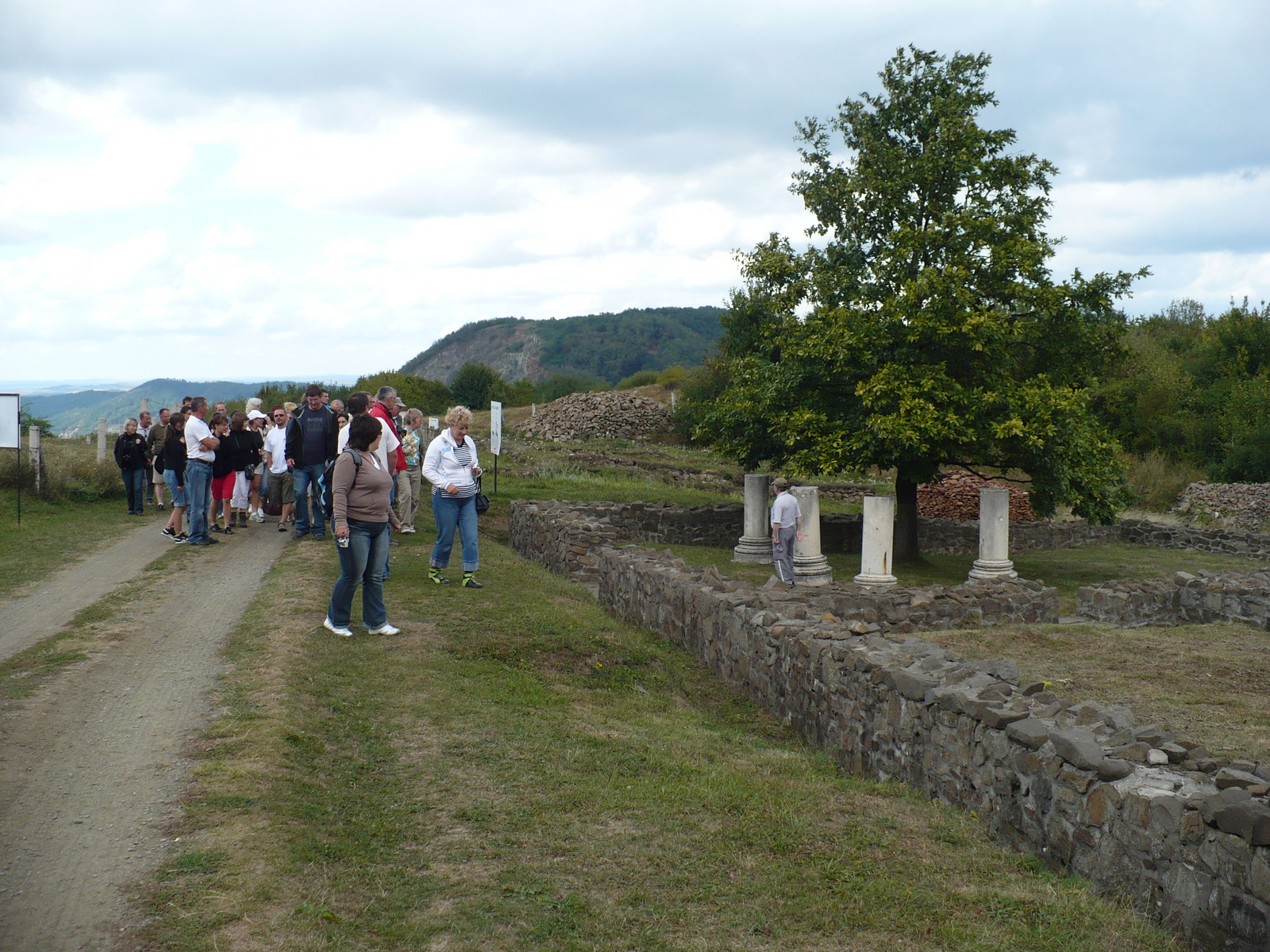
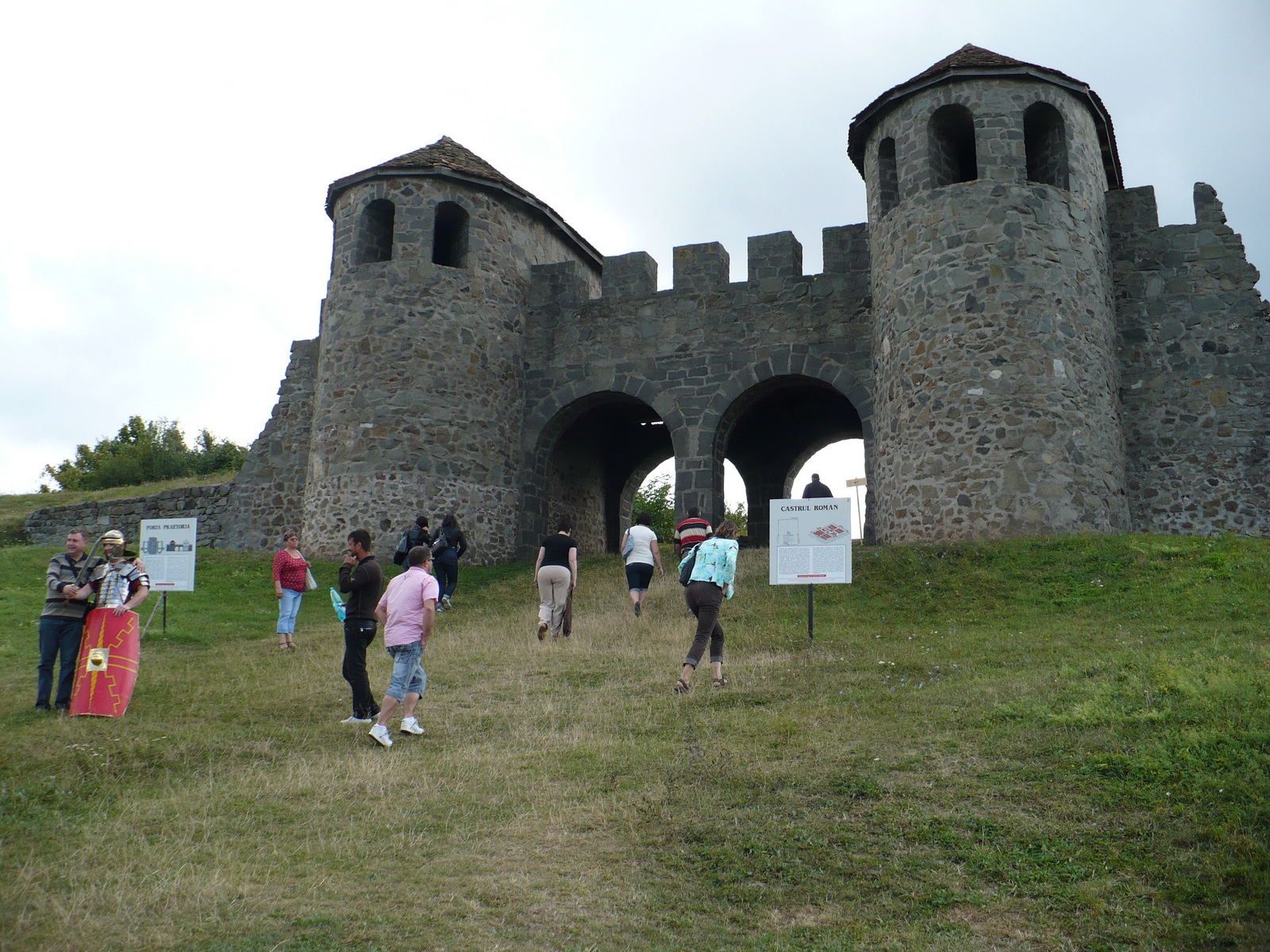
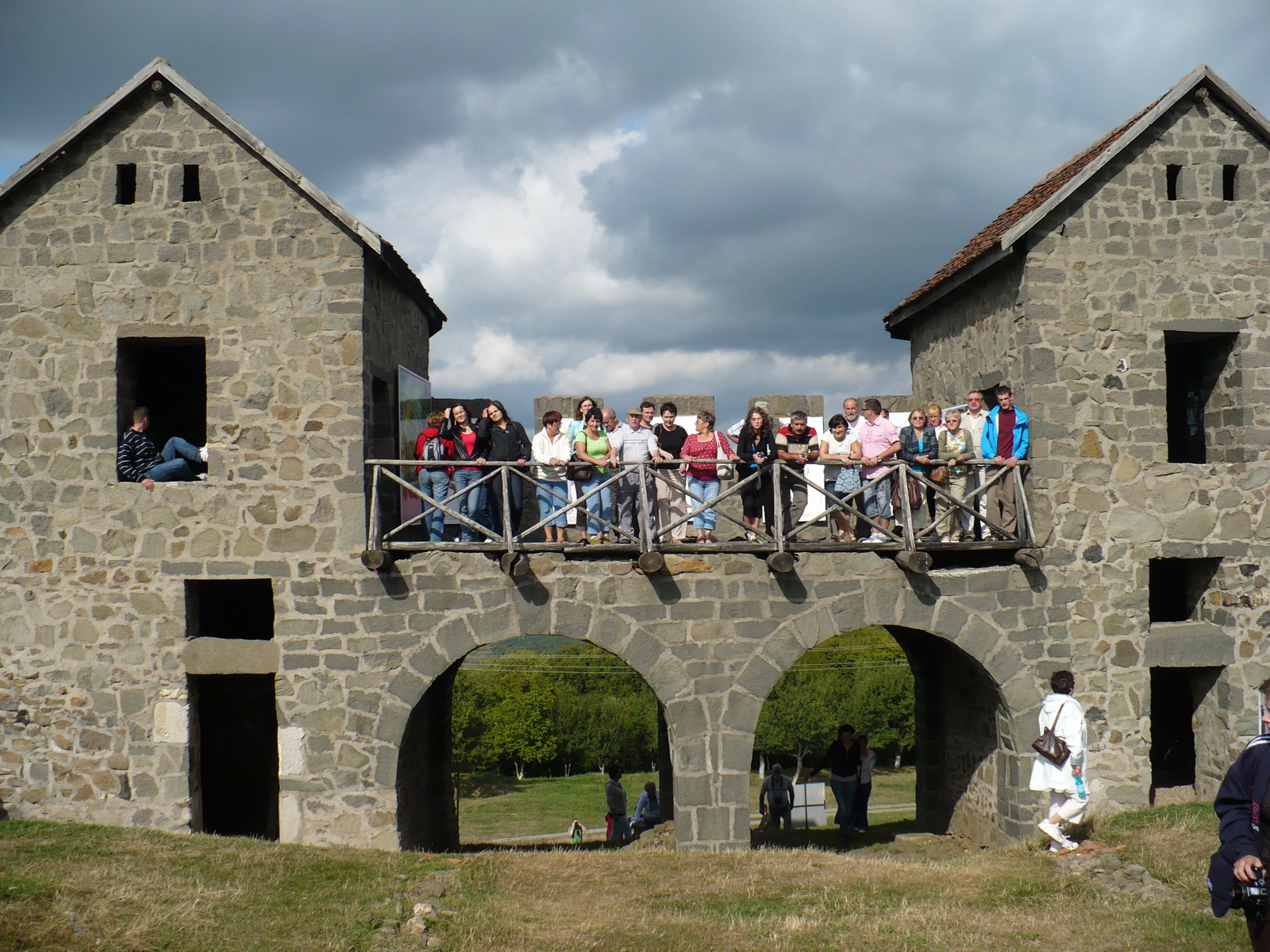
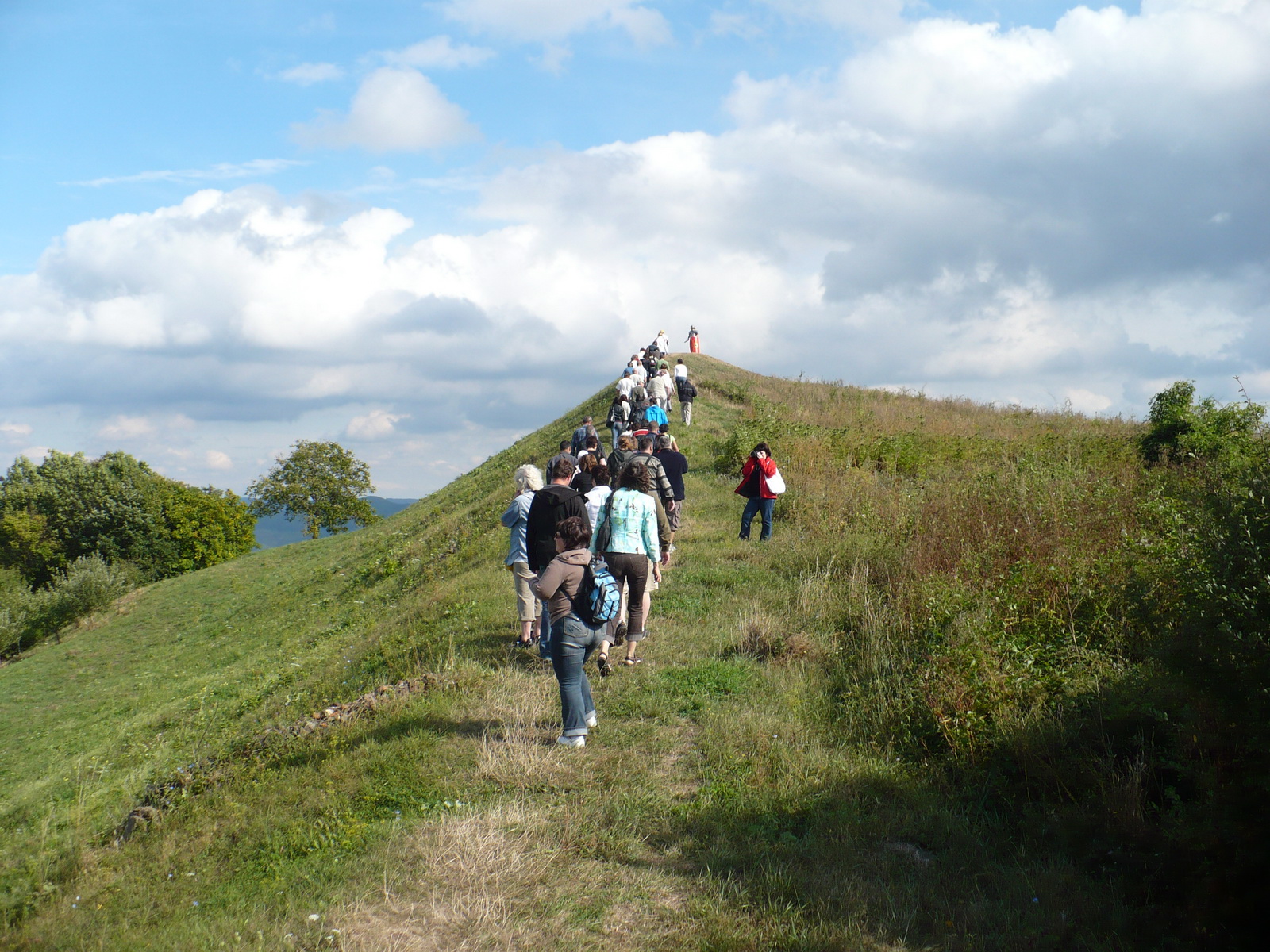
THE STONE AGE – The first signs of habitation on Măgura Moigradului, belong to the Neolithic period, and the discoveries are datable back to 4800-4500 B.C. Several dwellings and a food shelter was assigned to this period.
THE BRONZE AGE and THE FIRST IRON AGE – Even from the second half of the 19th century there are numerous notes that refer to the discovery of prehistorically objects in the area of Porolissum – Moigrad.
The private collections of antiquities, as well as the one of Wesselényi family from Jibou or Andrássy from Gârcei got rich out of several objects that originated in this area. They said that the peasants that used to work the lands of the noble families could pay their duties also by the antiquities that they found in Moigrad area.
There have been made several archaeological discoveries on Magura Moigradului dating back in the Bronze Age (approx. 2500–1000 B.C.). It is about pottery and a bronze ax that is in the collection of the History and Art Museum of Zalău. This last piece represented to the tribes in the Bronze Age from South East Europe, the main form of expressing the social status of the beholder. In other words it was a sign of power in the first place, and only secondly that was a weapon.
By the end of this period, around year 1000 B.C. one can find various bronze objects that were found in true thesauruses. They are 5 or 6, and were accidentally found by the end of the 19th century – beginning of the 20th century and they are today in the collections of national and international museums. Hundreds of bronze pieces that gather a significant quantity in metal (certainly a wealth by those times) suggest that around year 1000 B.C. and in the next century there was an important power center in the antique area of Porolissum. This area thrived firstly due to the control that exerted on Poarta Mesesana pass that was cut by Ortelecului Valley. Until late, when modern roads were built, this pass stood as a main passage that connected central and northern Transylvania with the Upper Tisa.
From these thesauruses it can be seen numerous bronze vases, that was an asset of warrior aristocracy, and also weapons or decorations. The seat of this power center in the area of Moigrad was not yet discovered, but there are several clues that lead us to ”Dealul Cămnin” from Jac village, Creaca, where there was briefly researched a citadel with earth bank and a defense ditch.
DACIAN AGE (2nd century BC – 2nd Century A.D.) Poarta Meseşană pass and its defence were made by the Dacian kingdom, by the Dacian state, by their system, with the fortifications at the top of the hills: Poguior, Citera and Măgura Moigradului. Citera Hill stands as an isolated height with three steep sides, and a forth that is a connection from South West towards Pomet Hill. On Citera Hill the Romans built a fort for auxiliary troops. This was located about 500 m East – North – East to the Eastern corner of the fort on Pomet Hill. The archaeological diggings from 1958 revealed a level that was fired during the Dacian habitation. By 1958 there was found an earth room that seems as an annex, which was, at the beginning and also later on, described as an inner ditch. The subsequent archaeological research that studied the layout in several places proved that this bank was in fact the shoulder of the ditch that was visible from the surface. Currently this is blocked with the remaining of another bank. On the Southern and Northern part the path of the bank and ditch may only be presumed, the steep slides together with the anthropical factors (on the Southern side there are still visible the Roman areas for mining the rocks needed to erect the fort) destroying or hiding the shape of the settlement. Therefore the presumed room suggests a somehow rectangular shape with the sides of about 300x200m, the shape of the room following the geological level difference line, located at least 15-20m lower than the maximum height of the hill. Even though none of the archaeological research performed at this settlement found any archaeological material, one can make the assumption that this settlement was built in the Dacian age.
The presence of the fort from Măgura Moigradului in the area of Meseş Gate is not at all by chance.
\r\n
This compulsory pass point, the main access for the North West routes towards and from Transylvania, stands as a vital path that was used both by merchants and by anyone that sought to enter or exit Transylvania.
Hill of volcanic origin, a massive mass of rock (andesite, granite etc.) that is still mined today of a quarry on the South-Western side of the hill, Moigrad Hill stands as a magnificent cone with the maximum height of 514 m, and with a level difference of 224 m to the valley of Ortelec, that had created the named pass. The upper plateau of the mentioned volcanic cone, in oval shape, has a large diameter of about 400 m and a small one of around 250 m, with a total surface of 7 hectares. Entered early in the literature because of the discovery of a Dacian thesaurus of silver ornaments or coins, and later on after archeological researches from 1938-39, 1940-41, 1958-1959. Considered at first a Dacian necropolis of cremation, Moigrad Hill appears increasingly as a large and prosperous Dacian fortified settlement, preceded by an area with religious character dating in the second half of the 2nd century B.C.
ROMAN ERA (2nd – 3rd century A.D.) After the defeat and the submittal of Decebal’s kingdom, the Romans used to the maximum these strategic possibilities offered by the old fortifications and roads previously made by the Dacians.
Thus, directly in the pass defended by the Dacian fortification on the Poguior Hill, the Romans built a fort of 80 x 65 m and a defending wall which blocks the entire pass, and over the Dacian fortress from Citera hill they built a fort for the specially made unit of palmyreni archers. Taking the name of the old Dacian dave from the Măgura Moigradului, Porolisso, and having as basis the tactical realities of the area as a pass, realities remarkably used by the Dacians, the Romans built here one of the most important and complex defending system known as the Porolissensis limes. At the end of the Dacian wars fom 106 A.D. summer, the Roman Empire conquered and organized as Roman province the land of the Decebal’s kingdom. In the North-West part of Dacia, on Meseş Mountain, the Romans emerged and organized the frontier (limes) which separate the area conquered by the Roman Empire, by the unconquered and unenclosed areas in the administrative unit of Dacia province, territories inhabited by free Dacians and other barbarian tribes (Sarmatians, Vandals). The Roman border – the limes – of the Roman Empire from Meseş Mountain was built of approx. 60 surveillance towers made of stone and wood. In front of the towers, on the crossing points, there were built earth and wood fortifications, with ditches, banks and defending palisades, and in the back of this line of towers and linear defending fortifications, at a few kilometers away, there are settled the Roman forts from Bologa – Resculum, Buciumi, Românaşi – Largiana, Romita – Certiae, Moigrad – Porolissum and Tihău on Someş valley, and the Sutoru – Optatiana fort ensures the control over the imperial road Napoca – Porolissum. A bank and a defending ditch of about 8 kilometers long were identified in front of the civil complex of Porolissum.
The defense of the Poarta Meseşeană pass (Ortelec valley) was ensured also by a defensive stone wall stone, identified on approximately 6 km. These complex defensive systems built by the Romans in England - Hadrian’s Wall – and the ones in Germany “Agri Decumates” or the forts of the Roman Palmyra.
Due to the special strategic importance of this defensive system – limes porolissensis – that was built by the Romans in the area of Porolissum, the Roman emperor Hadrian, around 120 A.D., when the entire Dacia province was resettled, he would organize to the North West of Dacia, the subdivision Dacia Porolissensis, with the capital at Porolissum, so as for Dacia Apulensis there was the capital at Apulum (Alba Iulia), or the Southern province Dacia Malvensis, with the capital at Malva. Taking into account the strategic setting of Meseş Gate, for the only accessible valley in the natural mountain barrier (Meseş Mountain), the Roman Empire built at Porolissum an important military site for the approximately 3500 soldiers in the auxiliary troops and Roman legions that were permanently or temporary settled in the two large Roman forts and in five smaller forts of burgus type. The large fort located at Pomet Hill was 300 x 240 m in size and the largest fort for auxiliary troops built in Roman Dacia, and the permanent seat for the 5th Cohort of Lingons and 1st Cohort Britanica, and from the beginning of the 3rd century A.D. that was the seat also for the Roman troops made up of roman citizens 3rd Cohort Campestris civium romanorum.
In the fort from Citera hill sizing 110 x 90 m a special troop of fighters stayed for the free spaces on the fields (like the territories in front of Porolissum fortifications, towards Pannonia), troop of palmyrian archers brought from Palmyra, from the beginning of the 2nd century A.D. and who remained here at Porolissum. Known as Numerus palmyrenorum sagittariorum porolissensium, the unit had also a brigade of on horse archers. This special troop of “police on horseback” by their way of fighting (were very cruel with the enemies) were used by Romans in their raids from “barbaricum” to impress and keep under obedience the inhabitants of the villages surrounding the limes. Moving the Dacins from their dava from Magura Moigradului to the foot of Pomet hill and around this where the Romans had built the big fort, the Roman colonizer and the native Dacians had built a new settlement built after all the rules of the ancient world, settlement that takes the name of the old Dacian dava, meaning Porolissum. Around the Roman fort from Pomet is developing the civil settlement where the soldiers’ families were living. In the city’s defense wall area were discovered, on Sanctuaries Terrace, many temples among which Dyonysos temple, known to the Romans as Liber Pater, which was completely explored.
The archaeological researches made in this temple highlighted the reconstruction of the temple’s interior in a period subsequent to the departure of the Roman officials from city. By dividing the interior of the temple with wall made from reused roman monuments and the reuse of apses was obtained a paleo-christian basilica interior. Together with this Christian pieces (the lead cross, the peacock rush light, the vase with Christian symbols) discovered at porolissum, the presence of the paleo-christian basilica here, in the North West side of Dacia represents one of the most powerful argument of the apostolic Christianization of the Romanian people.
A very important moment in the life of dacian – roman community from Porolissum is represented by Septimius Severus success, the commander of the roman troop from Carnuntum (Vienna) from Pannonia, who, with the help of the roman soldiers from Dacia provinces (Porolissensis, Malvensis, Apulensis) became emperor accepted by the Senate of Rome.
Founder of the Severs dynasty at the beginning of the 3rd century A.D., the emperor Septimius Severus rewarded the loyalty of the soldiers and citizens from Porolissum, who helped him in his ascending, giving the right to build, on the army’s territory, and of the roman state, to the old campaigners from the limes porolissensis troops, to build a settlement with the statute of municipium – the new settlement is built under the name shown in the inscriptions of Municipium Septimium Porolissense. At the beginning of the 3rd century A. D. grouping the roman troops from Porolissum in the great fort from Pomet hill, on the spot of one of the auxiliary troops from Porolissum was built a new urban settlement, with street network and internal organization characteristic for the municipal settlements. To the new urban settlement developed on the 30 hectares situated in the South-East of dextra side of the great fort from the Pomet hill, it was discovered and researched partially the city’s forum, the Capitol and the macellum (city’s market). The construction works of the new big fort from the Pomet hill and of the new urban municipal settlement were defenetly finished by the year 214 A.D., when Porolissum receives the visit of Marcus Aurelius Antonnius (Caracalla) Emperor - son of the great Septimius Severus Emperor. With this occasion the city temples were repaired, the inscriptions discovered at Liber Pater temple reveal these works. The roman troops from Porolissum build an equestrian statue from bronze, in natural size, which represents the emperor as imperator with the roman salute with the right arm outstretched. Is the same type of statue like the one intact preserved in Rome and which represents the emperor Marcus Aurelius. By placing the statue in front of praetorian gate of the great fort from Pomet hill, the 3rd Cohort Campestris, which was staying in the Porolissum fort, shows the gratitude towards the emperor who doubled their pay and who now enters, with all the proper homage, the honor gate (praetorian) of the newly built fort under his reign and his direct contribution. The four inscriptions discovered at the four entrance gates reminds of this fact, that Emperor Marcus Aurelius Antonnius – Caracalla – Fecit- made this settlement (the fort).
The city and the entire Porolissum area developed economically in a vertiginous way, because of the very good business conditions represented always by the commercial trade with the barbarians beyond the limes. The luxury pottery products reached far away in the barbaricum near the south of Poland, Slovakia and Eastern Hungary. Not by change were identified at Porolissum more workshops which faked the coins, surely used in the trade with the locals. The typically roman life, mentis romana type is developed at Porolissum also, as a province capital city. The city population and the other residents (soldiers and their families) were around 15000 when Emperor Caracala and his mother Iulia Domna reached Porolissum in 214 A.D. Here were examined the new military fortifications (the new fort with stone enclosures and gates) and surely they witnessed shows which were prepared and took place in the roman amphitheatre from Porolissum. The roman amphitheatre from Porolissum at the beginning was built of wood and in the year 157 A.D. under the direct command and financial support given by the Emperor Marcus Aurelius, it was built of stone. As a total arena surface, the arena of the Porolissum amphitheatre exceeds the one of the Ulpia Traiana amphitheatre – Dacia capital city – colony built by Emperor Traian.
EARLY MEDIEVAL PERIOD (7th – 13th century) Although at Porolissum take place researches for a long period of time, there are few traces of the early medieval period. For now, at Porolissum there were discovered no archaeological vestiges dating 7th – 9th century. From 10th – 13th centuries we have an inhumation cemetery in the roman municipality area, near the forum. Very interesting are the sanctums from Jac area from “Camin” and “Viile jacului” points, sanctums which are not yet archaeologically examined. It is not excluded the possibility that these are dating from the early medieval period. At Moigrad on the “Măgură”, through systematic archaeological excavations were found the remaining of an early medieval fortification.
Artifacts discovered here set the earth fort in the 10th -13th century. The most important point for crossing the line of the Meseş Mountain, Poarta Meseşeană made its debut in the historical literature, especially because of the discoveries of roman era. The infrastructural aspect of the pass, not only that it ensured military elements very well adapted to the field, but they also contributed to the economical development of the area in which it was settled, respectively of the areal it serviced. Talking here mainly about the salt transportation, of which intensification can be observed best during the Middle Ages. From the military point of view, we mention some important events from the early medieval period which involved Poarta Meseşană: the first raids of the Hungarians, the military campaigns against the Cumans and Pechenegs, of the Hungarian king Ladislau the 1st the Saint, or the pass use be king Andrei the 3rd (in January 1291) on his way towards central Transylvania. The medieval early discoveries dated in 10th – 13th century, prove the military aspect of the area that surrounds the pass. The archaeological researches from Moigrad “Măgură”, Jac “Cămin” and Ortelec “Cetate” prove an intense fortification activity of the area during the early middle age period (10th – 13th century).



.JPG)
.JPG)
.JPG)
